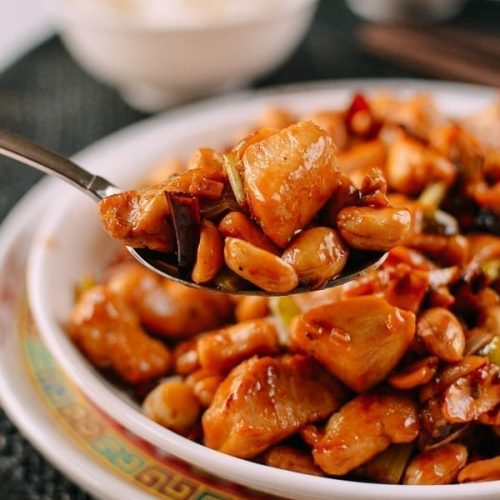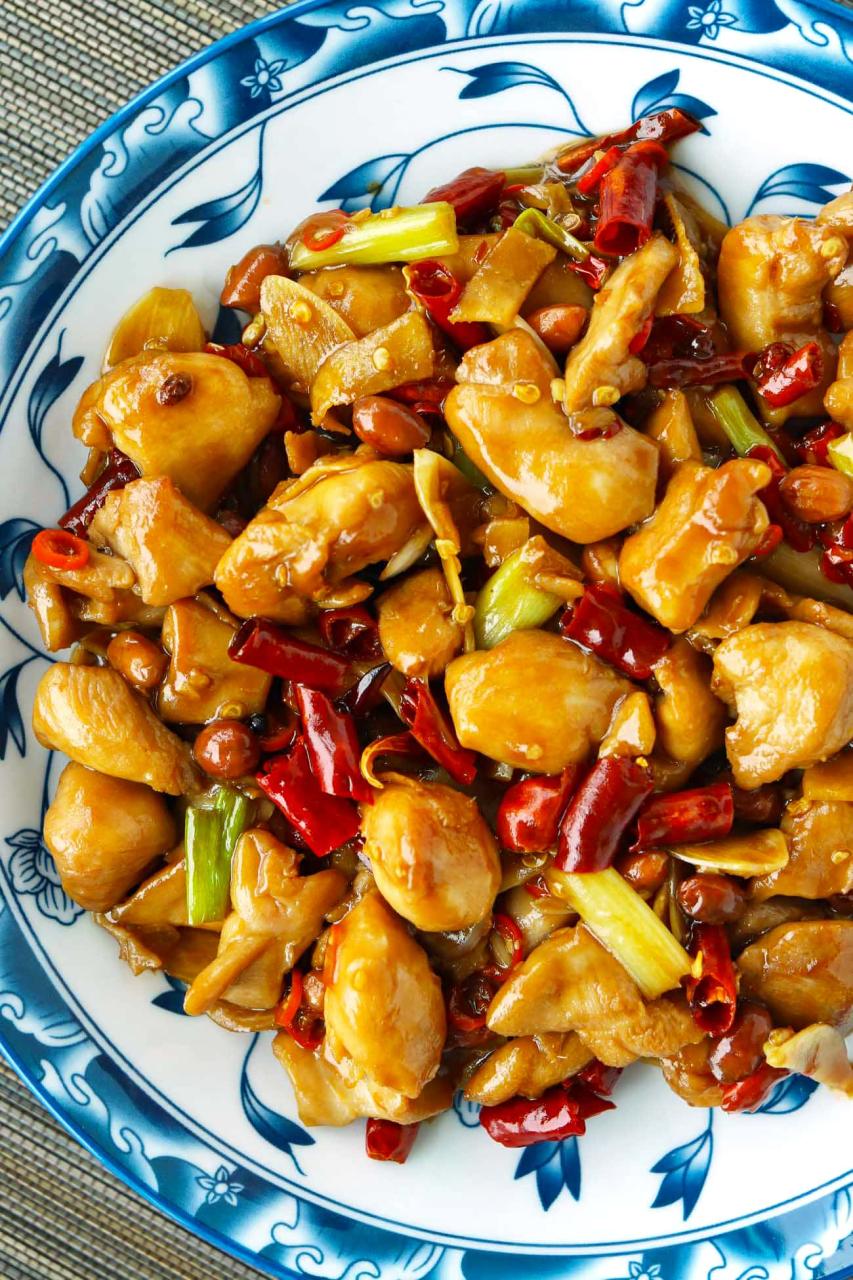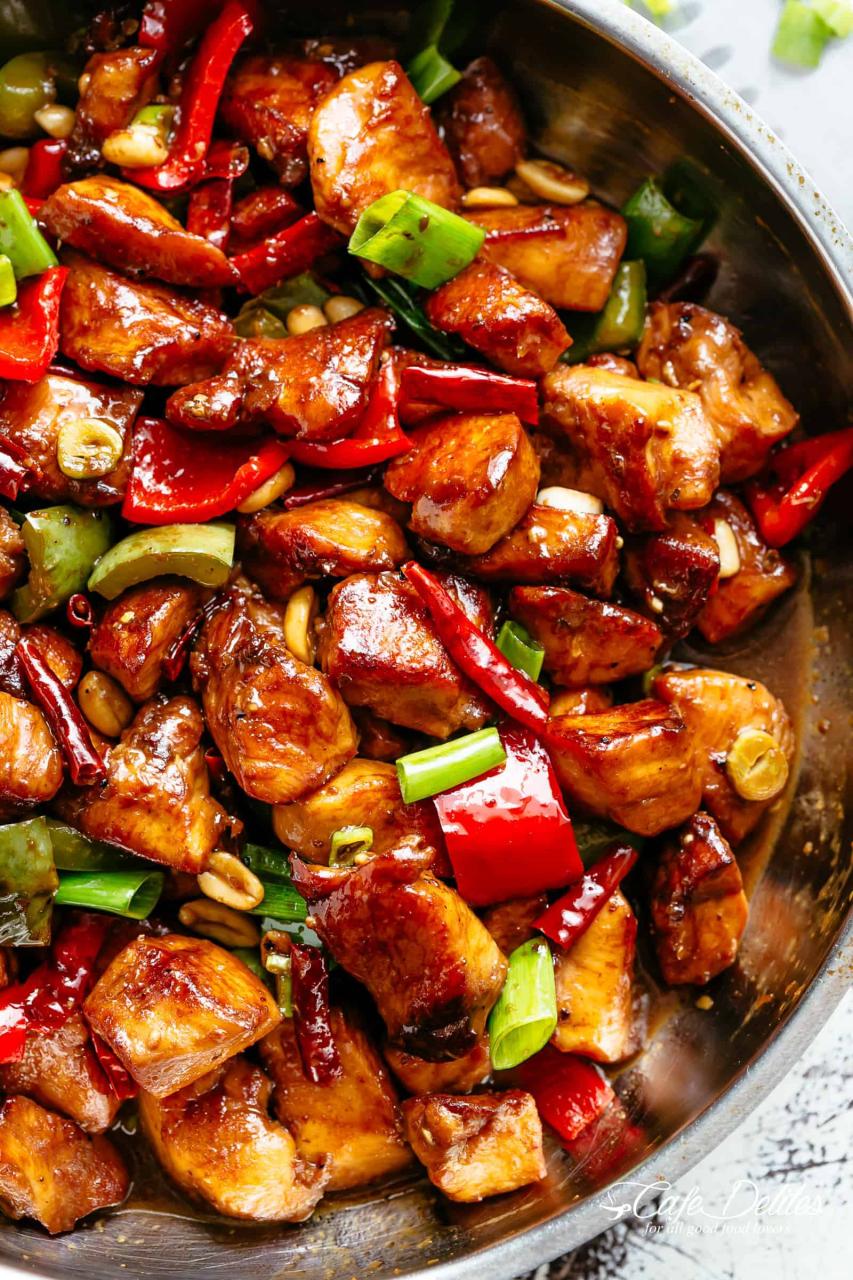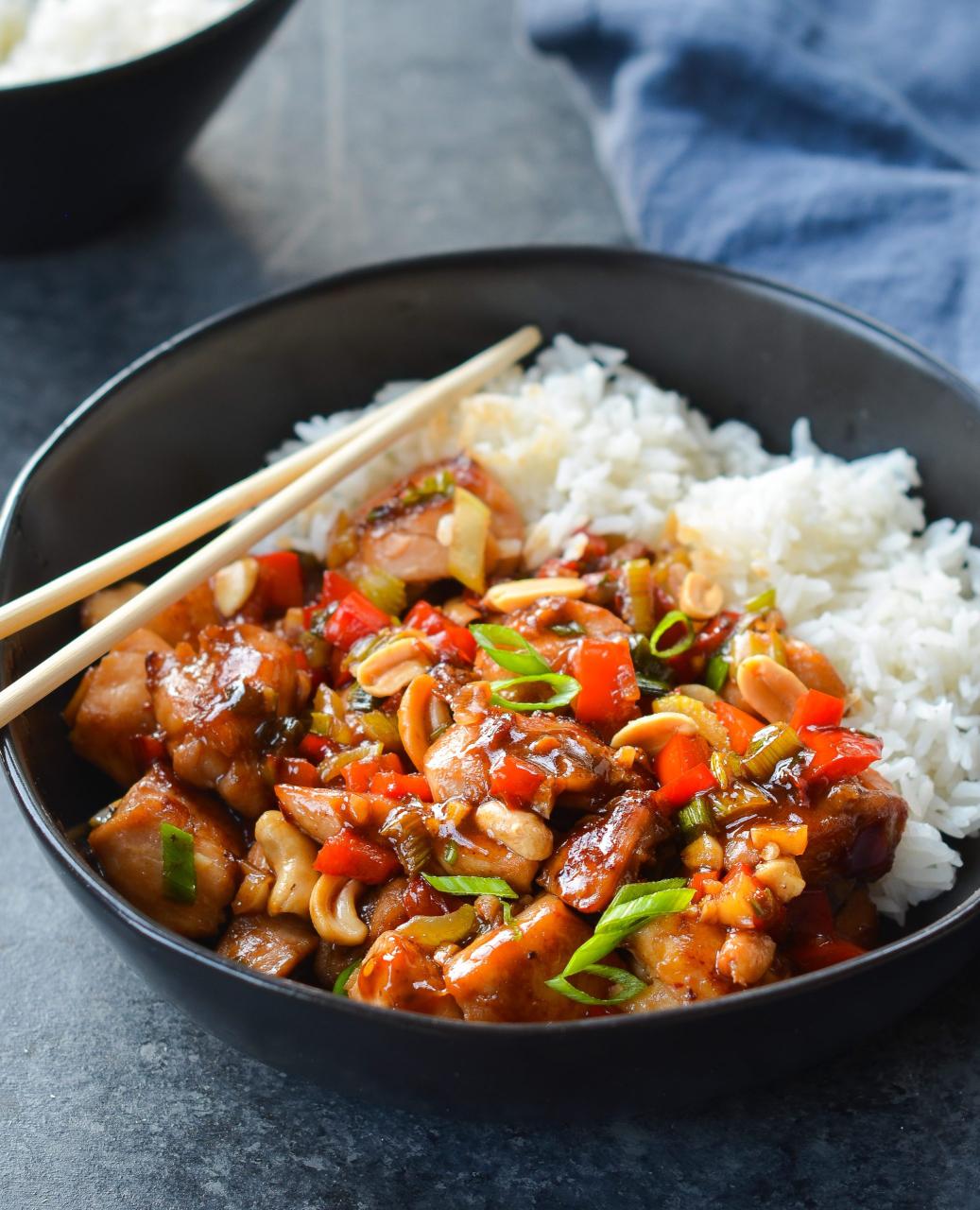Traditional Chinese Chicken Kung Pao, а slight bump to the Chinese kitchen on my side. Approved by the pets again. I’ve been watching two great Chinese chefs for a long time, with a lot of cooking, emphasizing the fried, but it finally shows that they are frying every
thing fast, on very strong fire and for a short time explaining that this way the fried is not harmful. According to them, this recipe is actually from Sichuan cuisine.
Not that I understand them both. I do not avoid completely fried. Whenever possible. It is important not to overdo it. I did not find Sichuan pepper – pepper, which uses the seeds of the seeds, not the grains themselves. According to the descriptions, they are lemon-flavored and can be replaced by pepper melange, as I did. Peanut butter was not really looking – I prepared the chicken with sunflower and sesame oil.
The latter is also very fragrant. In fact, I only needed it, because I have rice vinegar in the cabinet because of the dryness. And once I explained what provoked me to cook this spicy chicken with the sound name of Gun Bao Dzhi, I would say that it is literally cooked for 6-7 minutes, with just as many minutes of preparation, and if you have a roast pan, or at least a big one , wide, in which the meat will not crush but will fry – it is even better, easily and quickly. Sodium glutamate from the recipe I followed (there is a clip there) I missed it – for me this “preparation” improves the taste of something not so well prepared and is superfluous.
The thing I’m going to change next time – I’ll put the peanuts pre-baked. I ate meat with peanuts in the Chinese and were crispy; here they are fried, but they are not crunchy. Nothing that young people liked so much. The chicken is not hot. The peppers are stripped and cleaned from the seed, and when they are eaten, they only lie slightly. That’s why I wrote in the name that it was spicy; not hot.
Traditional Chinese Chicken Kung Pao Recipe


Traditional Chinese Chicken Kung Pao
Equipment
- 1 pan
Ingredients
- 300 g white chicken
- 1 egg white
- 1 tablespoon corn starch
- pinch of salt
- 100 g peanut peanuts
- the white portion of 6-7 stalks of fresh onions
- 5-6 spoons of oil peanut should be
- 5-6 chili peppers
- 3-4 cloves of garlic
- a piece of ginger
- red pepper
- 1 tablespoon corn starch
- 3 tablespoons light soy sauce
- 3 tablespoons white wine
- 1 tablespoon brown sugar
- 2 tablespoons rice vinegar
- 2 tablespoons sesame oil
- 1 spoonful of sesame seeds.
Instructions
- * Chicken is cut into bits of the same size.
- * Remove the whipped cream with a fork with a pinch of salt and starch, and with this mixture pound chips; stir and leave for 30 minutes to rest in the refrigerator.
- * Cut the onion into pieces about 2 cm (diagonal).
- * The chilli peppers are cleaved from the seeds. If the chips are large – they can be cut into pieces.
- * The oil is heated in the pan and fries in it for 2 minutes; they are taken out on a plate. !!! Here I will remind you, as I wrote above, that the peanuts are added to the peanuts at the end of the cooking.
- * In the same oil, chicken bites are fried until they turn red on all sides – for about 3-4 minutes. They are taken out of the peanut dish.
- * In the fat fry the crushed garlic cloves, the chopped piece of ginger, thinly cut peppers, onion and chilli peppers – for about 2 minutes.
- * Starch, soy sauce, wine, vinegar and sugar, along with two or three spoons of water, stir until the sugar dissolves. .
- * Chicken bites are returned to the pan.
- * The sauce with the starch that we have already prepared is added to the pan – but not directly on the bites, but at the end of the pan and stir …… for about 2 minutes until this sauce thickens and all bites cover it 🙂 like a glaze.
- * Add peanuts, sesame oil, mix and immediately dispense in two dishes.
- * Sprinkle with lemon sesame – I will now say that, according to Master Minh, in Sichuan, the sesame is not pre-baked. Something we do here regularly when sprinkling a ready meal, or salads and starters – with baked nuts.
Video
Cooking Tips

- Marinate the Chicken: To ensure that the chicken is flavorful and tender, it’s a good practice to marinate it before cooking. A typical marinade includes soy sauce, Shaoxing wine, and cornstarch. The soy sauce and wine impart flavor, while the cornstarch helps to seal in juices and gives the chicken a silky texture once cooked.
- Prepare Ingredients in Advance: Stir-frying is a quick cooking process, so having all ingredients measured, chopped, and ready to go is vital. This is known as “mise en place.” Ingredients to prepare typically include garlic, ginger, green onions, dried chilies, and Sichuan peppercorns.
- Use a Wok: If available, use a wok to cook Kung Pao chicken. Its curved shape distributes heat evenly and allows for efficient stir-frying, which is at the heart of this dish’s texture and flavor.
- Control the Heat: Heat management is crucial when cooking Kung Pao chicken. Start with high heat to sear the chicken and develop flavors, but lower the heat if ingredients are cooking too quickly or burning, especially when adding the garlic and dried chilies to prevent bitterness.
- Sichuan Peppercorns: A signature ingredient in Kung Pao Chicken is Sichuan peppercorn. It’s important not to confuse these with black peppercorns as Sichuan peppercorns have a unique aroma and a slightly numbing effect on the palate. Toasting and grinding fresh Sichuan peppercorns releases their aromatic oils and enhances the dish’s flavor profile.
- Balance the Sauce: The sauce typically includes soy sauce, dark soy sauce for color, black vinegar for acidity, sugar for sweetness, and sometimes a bit of chicken stock for depth. Adjust the balance of these elements to achieve the characteristic complex flavor profile – a mix of salty, sweet, sour, and spicy.
- Add the Peanuts Last: Traditional Kung Pao chicken features peanuts, which provide a pleasant crunch. To maintain their texture, add them towards the end of cooking so they don’t become soggy.
- Serve Immediately: To enjoy the full flavor and texture, the dish should be served promptly after cooking.
Serving suggestions

The preparation of Kung Pao Chicken generally involves marinating the chicken in a mixture of soy sauce, Shaoxing wine, and cornstarch which serves to tenderize the meat and add flavor, as well as giving it a silky texture. The dish is commonly seasoned with a combination of soy sauce, sugar, and vinegar to create a balanced sweet and sour taste, which is enhanced with the heat of dried chili peppers and the numbing effect of Sichuan peppercorns.
A key aspect of Kung Pao Chicken is the ‘holy trinity’ of garlic, ginger, and scallions which are stir-fried to provide a fragrant base for the other ingredients. Crunchy peanuts or sometimes cashews are added for texture contrast, and the dish is often garnished with green onions.
Serving suggestions for Kung Pao Chicken typically include a bed of steamed white or brown rice to help absorb the rich flavors of the sauce. For those who prefer noodles, it can also be served over a bed of lo mein or chow mein. A side of sautéed or steamed vegetables, such as bok choy or broccoli, can provide a fresh contrast to the dish’s rich flavor and help balance the meal.
In addition to these traditional sides, modern variations may introduce other vegetables such as bell peppers, zucchini, or snap peas into the stir-fry for additional color and nutrition. To cater to various dietary preferences, one could also create a vegetarian version using tofu as a substitute for chicken.
When enjoying Kung Pao Chicken, one should be mindful of the spiciness level. The inclusion of dried chilies can be adjusted to individual tolerance, and the use of Sichuan peppercorns can be modulated to control the numbing sensation that characterizes Sichuan dishes.
Top 5 FAQs about Traditional Chinese Chicken Kung Pao

- What are the main ingredients in Traditional Chinese Chicken Kung Pao? To create an authentic Kung Pao Chicken, you would typically use diced chicken breast or thigh meat, as the protein is the star of the dish. The chicken is commonly marinated in a mixture of soy sauce, Shaoxing wine, and cornstarch for tenderness. Supporting ingredients include Sichuan peppercorns, dried red chilies, garlic, ginger, green onions, and peanuts or cashews. The sauce component often contains soy sauce, sugar, vinegar, and sometimes chicken stock to create a complex flavor profile.
- Is Kung Pao Chicken very spicy? The level of spiciness in Kung Pao Chicken can vary greatly. Authentic Sichuan Kung Pao Chicken tends to be quite spicy due to the generous use of dried red chilies and Sichuan peppercorns, which provide a unique numbing sensation. However, versions served outside Sichuan or in Westernized Chinese restaurants can be less spicy, catering to a wider range of palates.
- What is the difference between authentic Kung Pao Chicken and the Westernized version? Authentic Kung Pao Chicken places emphasis on the balance of spicy, numbing, and savory flavors characteristic of Sichuan cuisine. It often uses more Sichuan peppercorns and dried chilies, and may include other regional ingredients such as Tianjin preserved vegetables. Westernized versions are generally sweeter, less spicy, and may include bell peppers, zucchini, or other nontraditional ingredients to appeal to local tastes or to add color and variety.
- Can Kung Pao Chicken be made without nuts? Nuts, like peanuts or cashews, are a standard ingredient in Kung Pao Chicken, providing a contrasting texture to the dish. However, for those with allergies or preferences, it’s entirely possible to omit the nuts. The fundamental flavors of the dish are retained through the usage of spices, marinades, and the sauce.
- How can I achieve the distinctive “wok hei” flavor when making Kung Pao Chicken at home? “Wok hei” refers to the slightly charred, smoky taste that comes from cooking on a very high heat in a well-seasoned wok. To simulate this at home, ensure the wok is very hot before adding oil, and do not overcrowd the pan with ingredients to avoid dropping the temperature significantly. Cook in batches if necessary. Stir fry the ingredients quickly and consistently to give them direct contact with the hot surface of the wok.
Due to its widespread appeal, Chicken Kung Pao can be seen as a cultural ambassador for Sichuan cuisine, sparking interest in its culinary traditions and encouraging the exploration of other Sichuan dishes. Its adaptation in various cuisines around the world is also a testament to the dish’s versatility and the global palate’s acceptance and enthusiasm for Chinese flavors.
In conclusion, Traditional Chinese Chicken Kung Pao is a venerable and beloved Sichuan dish celebrated for its bold flavors and delightful textures. Its notoriety and appreciation globally exemplify the dynamic nature of culinary traditions and the interconnectedness of world cuisines.